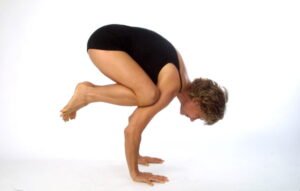
Why was Eve doing those poses?
This is a very good question. One we should be considering each time we come to our yoga mats.
I get asked occasionally whether the way I used to practise yoga might have led to my hip osteoarthritis.
I was diagnosed with this condition when I was 47 years old. It’s unusual for a person of that age to have developed such a serious condition.
Who knows why I did? You can tell your stories many different ways. I usually say it’s entirely possible that I simply pushed too hard in yoga. Or maybe that the way I was practising poses wasn’t ‘correct’. But then, to be honest, in those days I was doing mini triathlon training, playing tennis, cycling and pursuing a busy lifestyle, too.
Maybe genetics contributed to the erosion of my hip cartilage. Hard to say, as both my parents died early.
I do wonder, looking back, why I did push myself in all these activities. Why did I do poses like Ekapada Raja Kapotasana (pigeon pose) or Astavakrasana (8 angle pose) or Ekapada Sirsasana (leg behind the head pose)?
Was I testing myself! Showing off? Competing with other yoga teachers? Probably a mix of all three.
Another way
Older, wiser, and the owner of a relatively new set of hips (prostheses), I’m scratching my head over why I did yoga that way.
I told myself it was fun. But really, I was avoiding being in touch with myself, with what my body and soul really needed. That is, not to be flogged, pushed or even cajoled into ‘advanced’ poses. Poses that Peter Blackaby, author of Intelligent Yoga, calls ‘yoga exotica’.
I needed a more considered approach, one in which I was listening to my body. Doing as my friend, Donna Cavanough says, ‘starting slowly, then easing up.’
Good thing is, it’s never too late.

It’s no longer surprising but still wonderful and humbling to hear your honest take on ‘advanced poses’ Eve.
I’ve just started reading Peter Blackaby’s book. I’m excited to hear more about how my yoga practice can support my function, my energy and balance out the toll that my job exacts on my nervous system. Not drive my body to achieve poses that more often than not compromise my shoulders and neck.
This afternoon I chose to spend half an hour in restoratives to rest a twingy shoulder but more importantly, my whole Not so long ago I would have opted for a strong physical practice or even somatic exercises to ‘do’
Now I choose to do less. I am slowly coming to embody less is more. Especially when injured. It doesn’t mean you have to stop moving. I still walk up mountains when I can. But my yoga practice is now turning into a beautiful healing modality instead of a regimen or discipline.
You, Donna Farhi,LIsa Peterson, are all teachers I admire immensely. And all of you seem to be gravitating to the same conclusion about yoga asana. What is our intention and how do we go about it. Instead of hiding from our feelings, as you alluded to, re-connecting by re-noticing ourselves. Vs pushing our limits. The bottom-up approach. I’ve been exploring Feldenkrais and Alexander Technique of late with some amazing teachers here in Canberra and they have taught me that my brain is the main ‘muscle’ I need to learn how to modify whilst interacting with life.
Thank you Eve for always shedding light.
Katrina
I’m so encouraged by your discoveries, Katrina. Body self-flogging is really a thing of the past for veteran practitioners. There’s so much more subtlety in doing “intelligent yoga”. Enjoy!